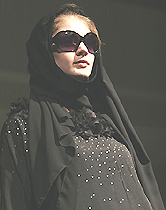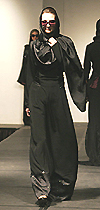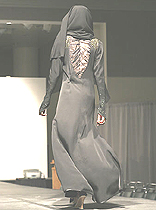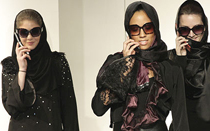VOA标准英语2008年-Students Discover Culture Through Fashion Desig(在线收听)
By Faiza Elmasry
Washington, DC
04 June 2008
The abaya is a traditional head-to-toe over-garment for women in the Persian Gulf countries. Women wear it for modesty and protection from the hot, dry climate. This typically shapeless, black garment was the unlikely focus of an assignment for fashion students at an American university. The assignment tested the students' creativity and ability to understand how women in many Islamic countries express themselves by covering up.
 |
| Women in the Persian Gulf countries wear abaya for modesty and protection from the hot, dry climate |
Frilly red lace is not usually associated with the dress of women in traditional Muslim countries, but that's what's on Jessica Goodspeed's abaya. Working with a classmate at Virginia Commonwealth University in Richmond, she came up with the innovative design.
"We created a Spanish or Flamenco inspired design that had lots of black and red lace, very beautiful," she says.
 |
| Jessica Goodspeed's abaya is a Flamenco inspired design with lots of black and red lace |
The assignment was very challenging for the fashion-design major. "I didn't really know a lot about it or understand a lot about why they wore it, or the specifics about the garment, Goodspeed says of the abaya.
"We had a lot of people come and speak to us about them. I really think it's amazing to be able to wear an outer garment that can tell who you are, and at the same time protect your privacy and be fashionable."
 |
| Abaya is no longer a simple black garment; it's becoming more ornate |
Her classmate Natalie Hakim already knew about abayas. Her Lebanese heritage gave her a better understanding of the garment as a cultural tradition. She says throughout the semester, it was interesting to see the project changing her classmates' perception of the abaya and the women who wore it.
"A lot of the girls felt like, 'wow, these women are so oppressed under these garments. This is horrible,'" she says. "I don't think they truly understood that this is not something that the women feel that they have to hide under. This is their culture and they are proud of it. A lot of the girls through this semester became more accepting of it. By the end of the semester, we were trying on the abayas. It wasn't so much of an awkward thing anymore."
 |
| Guthrie says such projects help her students become better people and more innovative fashion designers |
Kim Guthrie is an assistant professor of Fashion Design and Merchandising at VCU. "It's a great vehicle to expose these young people to. Yes, there is a whole other big wide world outside Richmond, Virginia," she says.
The Abaya Project is part of her Give Me Shelter Class, in which students discuss the idea of clothing as shelter and how different cultures address the concept of clothing.
"From that, the students actually took the time to design the abaya," she says. "You can call it a black canvas, if you want to. All they had to do, which sounds easy but not so easy, was to make sure that the garment covers what it's supposed to cover. Aside from that, they could change the actual way the abaya is cut, whether how the sleeves are seamed or how the body is seamed, how the closure works in the front. They were able to play with all of those design details."
The students also got to embellish their abayas, because, as Guthrie notes, "now the abayas are becoming more and more fancy, beading here and embroidery there. So it's not longer a simple black garment."
 |
| The Abaya Project gave students a better understanding of how women in many Islamic countries express themselves by covering up |
This project is one of many collaborations between VCU students and faculty in Virginia and its sister campus in Doha, Qatar. The 20 students in Guthrie's class designed 10 abayas. All the designs were shipped to the VCU campus in Doha. Local fashion experts there critiqued and tweaked the designs and sent them back to Richmond for final embellishment.
"When the abayas came back to campus, we opened the big box," she says. "It was like a birthday party, a huge celebration. Everybody wanted to have their abaya picked first, wanted to look at it and see how well it looked. So it was very exciting for them."
Natalie Hakim says the real test came when the abayas were modeled in the university's annual student fashion-design show.
"We had a lot of family members at the fashion show who had known what we had been working on," she says. "Even the students in the Fashion Department that were not taking the course, were really excited to see what we had come up with and they loved it. They thought the pieces were stunning."
The abaya collection was also displayed in the annual fashion show at the University's School of Fashion in Qatar, where it received positive feedback. Now that it is back, the collection will stay in Richmond.
Kim Guthrie says she likes to see her students engaged in projects like this, so they become less judgmental and more open to inspiration from various cultures. That, she says, will help them become better people and more innovative fashion designers.